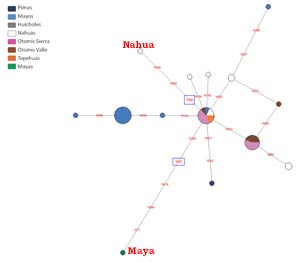|
On September 19, 2012, Amaya Gorostiza, Víctor Acunha-Alonzo, Lucía Regalado-Liu, Sergio Tirado, Julio Granados, David Sámano, Héctor Rangel-Villalobos, and Antonio González-Martín (from Spain and Mexico) published the paper "Reconstructing the History of Mesoamerican Populations through the Study of the Mitochondrial DNA Control Region" (Click here for the abstract and links to download the PDF of the paper and of the supporting images, which are mentioned in but not included in the PDF.) In particular, Figure S4 includes the mutations of Haplogroup D1. The label for the figure is "Median-joning network of the mtDNA sequences belonging to the D1 haplogroup in the indigenous populatons. (numbers represent the position of mutation defining a haplotype)." Click here to download the TIF file for Figure S4. 
Click on image for full size. As the label says, the red numbers are the mutation locations that determine which sub-groups (haplotypes) are split off from the main Haplotype D1 group (the multicolored circle in the middle). These numbers refer to values in the HVR1 results region, where Josie has the mutations 16223T, 16325C, 16362C and 16519C. My understanding (which could be wrong) of the image is that the mutation closest to the central circle is the one that defines which branch is taken. This is important in Josie's case, since her 16362 and 16325 mutations both appear in the image -- on different branches. Her 16362 mutation is the first one outward from the central circle on the upper left branch (whose white colored end node indicates it is Nahua). And her 16325 muation is the second one outward from the central circle on the bottom left (whose green end node indicates it is Maya). So my understanding is that the second and later numbers are later splits from the main split that determined the branch. This would then mean that Josie's mtDNA is most closely aligned with the Nahua branch and not the Maya branch. While this paper is ground-breaking work with great implications, it is also a building block upon which more detailed research will hopefully later be built. This later research will hopefully clarify the D1 branches and include all four of Josie's HVR1 mutations -- and will expand to include the HVR2 and coding region mutations. But at this time, based on my understanding of how to read Figure S4, it appears that Josie's mtDNA is Nahua. So does this DNA information conform with what we know of Josie's documented ancestry? The paper has a map of Mexico (Click here to download the TIF.) where the Nahua are shown in southeastern Mexico. This map also shows discs for each people, showing their relative proportion of Haplogroups A1, B1, C2 and D2. This seems to conflict with Figure S4, since the Nahua disc on the map shows more than 50% from Haplogroup A1. It also completely omits Haplogroup D1. I am inclined to believe the much more detailed Figure S4, since it shows the specific mutations of Haplogroup D1. But I could be completely wrong about my interpretation of these apparently conflicting images. The important thing for Josie is to note where the Nahua people were located in Mexico, so we can see if her maternal ancestry traces back to that location. Josie's mother, Mercedes Elizalde, and her mother, Josef Ruiz (1875), and her mother, Refugio Gonzales (1847), and her mother Manuela "Chepita" Marquez (1816) were all born at Colotlán, Jalisco. This is well to the northwest of the Nahua. But Chepita's mother, Ventura Lopez (1781) was born about 25 miles further south at Tlaltenango de Sánchez Román in Zacatecas -- as was her mother Maneula de Llamas (c 1753) and her mother Maria Alexandra de Avila (1720), who is the most distant maternal ancestor about whom I know the birthplace. Her mother, Josepha Ximenez (c 1690), had all of her known children baptized at Tlaltenango. But I do not know where she herself was born nor who her parents were. So the documentation only goes back to Tlaltenango. That is in the right direction to possibly have originated in southeast Mexico. But it is clearly not enough to verify the Nahua people as the origin of Josie's mtDNA. We may never be able to document it, since the records of this period did not all survive the centuries. And even if they did, it is possible -- as noted above -- that the connection (if I am correct in my understanding of the paper) with the Nahua may pre-date the earliest records. And keep this in mind: Finally, there is one other important consideration to keep in mind. Josie's direct-line maternal ancestry was just one of her many ancestral lines. She could very well have had Huichol ancestors, since it seems that the Huichol people were from near Colotlán. And she may have had other native people among her other lines. We may never know about these other peoples, since the DNA that they would have contributed would not have been in her mtDNA but rather would have been in her autosomal DNA, which is much more difficult to group by people and also is cut in half with each passing generation, so that by the 7th or 8th generation, the chances are slim that Josie would have the DNA from any one specific ancestor. Clearly, she had a complete set of DNA, so that some of her ancestors -- possibly some very far back -- contributed to her autosomal DNA make-up. But it is very difficult -- unless records exist -- to be able to tell just which ancestors gave her which DNA and which ancestors' DNA did not pass down to Josie in measurable quantities at all. |
 Send E-mail to wwjohnston01@yahoo.com
Send E-mail to wwjohnston01@yahoo.com